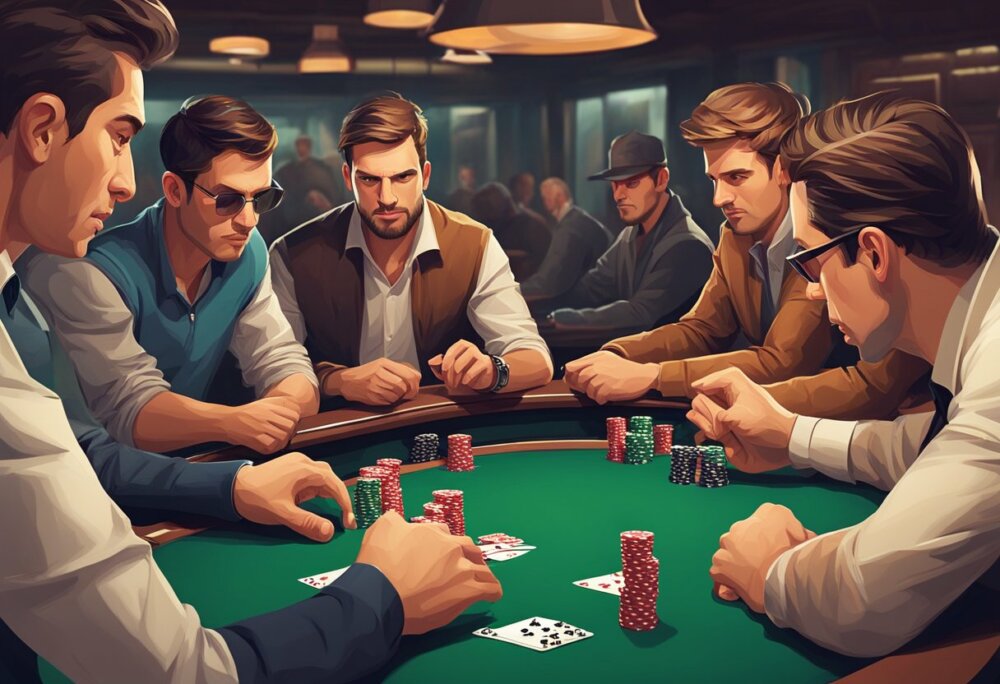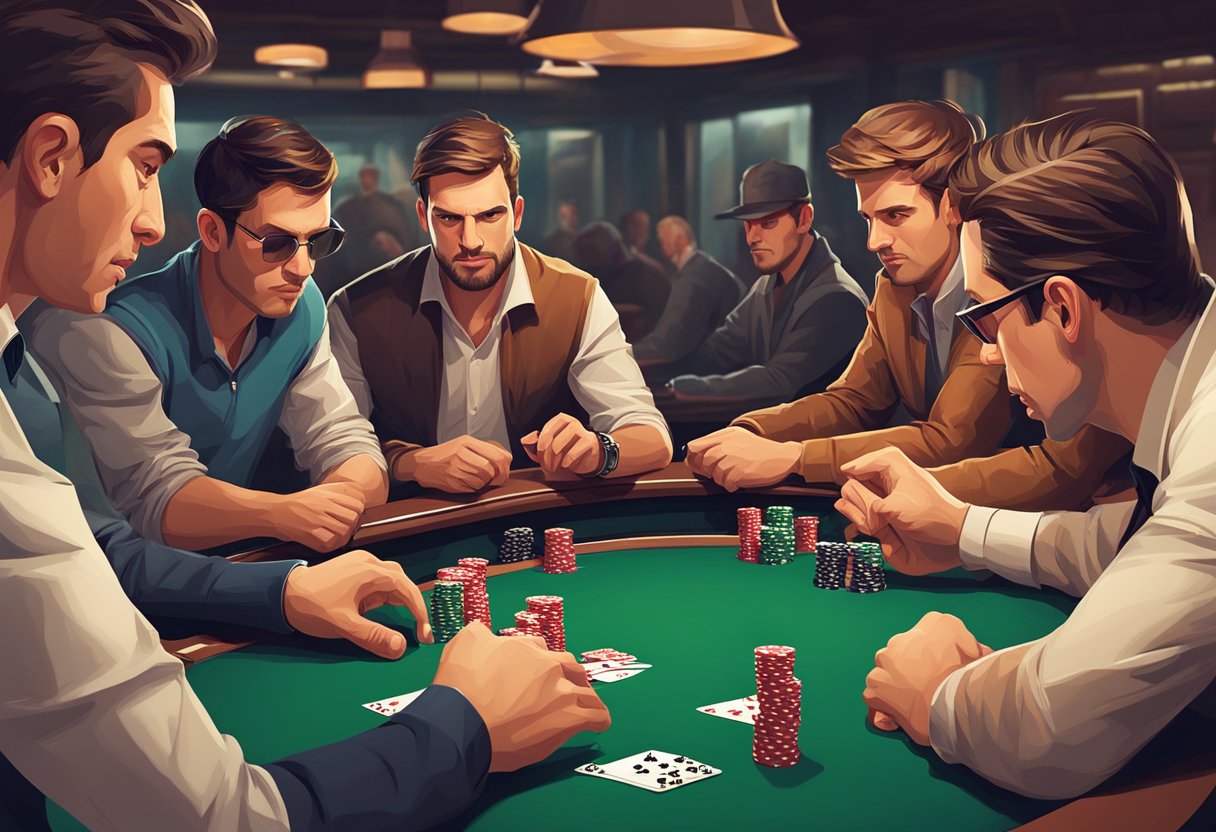Poker bluffing is a nuanced skill that plays a vital role in the strategy of the game. At its core, bluffing involves making bets or raises with a hand that may not necessarily be the strongest at the table with the intent of inducing opponents to fold superior hands.
While beginners might approach bluffing with trepidation, experienced players recognize its value as a tool for deception and control. Bluffing can create an image of unpredictability which, when managed correctly, becomes an invaluable asset in a player’s psychological toolbox. The team of online-casinos.ng has prepared 10 expert tips on how to bluff successfully
- Large number of games developed by leading software providers
- Easy to use website
- Great Sports betting and Live Casino
- Over 80 payment methods
- Nice bonuses for new and existing customers
- Option to bet live on a sporting event
- Lots of promotions for new and loyal users
- Plenty of available betting markets
- Nigerian Based Casino (Allows Naira)
- Combines Casino with Sportsbet offer
- Unique live casino games
- In-play betting on sporting events
- Lots of bonuses and VIP program
- Android and iOS applications
The efficacy of a bluff is not just a shot in the dark; it requires careful calculation and a solid understanding of poker dynamics. A successful bluff considers the current game state, including the number of players, their tendencies, and the visible hands on the table. The ability to read these situations and predict opponent reactions is what separates novice attempts from expert execution. Players who master this aspect can turn even a mediocre set of cards into a winning opportunity.
Understanding when and how to bluff also involves assessing the risk versus the potential reward. The art of bluffing is not about winning every hand but about knowing which hands are worth the gamble. It ties into the larger fabric of poker strategy, which balances the bluff-to-value ratio and how a player’s table image can affect the outcome of a bluff. Thus, the strategic deployment of bluffs—ranging from semi-bluffs with drawing hands to full bluffs when conditions are ripe—can pressure opponents and contribute to a player’s long-term success at the poker table.
Understanding Bluffing Basics
Effective bluffing in poker requires a thorough understanding of when to represent a strong hand and how to influence an opponent’s decisions. Below are vital elements of bluffing that every player must grasp to implement this strategy successfully.
Defining a Bluff in Poker
A bluff in poker is a deceptive play where a player bets or raises with a hand that is not thought to be the best hand. The primary intention is to cause opponents with superior hands to fold. It’s not just about the cards one holds; it’s about the perception they create in the minds of their opponents. A successful bluff can convince opponents that the bluffer holds a value hand when, in reality, they do not.
Types of Bluffs Explained
Pure Bluffs: These occur when a player has a hand with no perceived equity, meaning it has little to no chance of winning if it goes to showdown. Pure bluffs often take place when a player’s only hope to win the pot is to cause an opponent to fold.
- Example of Pure Bluff:
- Player A bets with a 7♠2♦ on a board of A♣K♦5♠Q♣, a hand with virtually no chance of being the best.
Semi-Bluffs: These involve hands that are not the strongest currently but have the potential to improve to the best hand on later streets, such as draws to straights or flushes. A player with a semi-bluff has some equity and, therefore, a backup plan since their hand could develop into a strong holding.
- Example of Semi-Bluff:
- Player B raises with 8♠9♠ on a flop of 6♠7♦2♠, which means they could still win with a straight or a flush on future cards.
Understanding these foundations of poker bluffing prepares a player to execute more complex bluffing strategies with confidence and precision.
Preparing to Bluff
Success in bluffing at poker hinges on strategic preparation and keen perception. A player must decide the opportune moment to execute a bluff and possess the proficiency to accurately read their opponents.
Choosing the Right Moment
A player should observe the position in relation to the dealer as it is critical for determining bluff viability. Being in a late position allows the advantage of seeing how opponents act before making a move. Furthermore, understanding pot odds and fold equity is essential. Pot odds need to be favorable; the player must risk less in comparison to the potential gain. Fold equity, the likelihood of an opponent folding, increases if the opponents have shown weakness or hesitation.
Key Factors to Consider:
- Player’s position at the table
- Size of the pot versus potential gain
- Probability of opponents’ folding
Reading the Opponents
Recognizing poker tells and patterns in opponents’ behavior is crucial when preparing to bluff. An opponent’s mannerisms or habits can reveal the strength of their hand. Players who have previously folded under pressure are prime targets for future bluffs. A player must scrutinize the table dynamics and the tendencies of opponents, seeking signs of passivity or aggression that can influence the decision to bluff.
Aspects to Monitor:
- Opponent’s previous reactions to bets
- Physical and behavioral tells indicating hand strength
- Patterns in betting and folding habits
Executing the Bluff Effectively
Effective bluffing in poker is a subtle art backed by calculated decisions on bet sizing, board texture analysis, and maintaining equilibrium in one’s playing range. It is a fundamental skill that can pivot the fate of a hand, depending on how well one executes these tactics.
Bet Sizing and Frequency
Optimal bet sizing is pivotal in executing bluffs effectively. Bet sizes should be convincing enough to fold out hands that have you beaten but not so large as to sacrifice unnecessary chips when called. A common strategy is to maintain the same bet size one would use with their value hands, creating indistinguishability between bluffs and genuine hands.
- Bluffing Frequency: Too frequent bluffing can make one predictable, whereas a seldom bluff can signal strength and might not be as effective. A balanced bluffing frequency considers pot odds and the chances the opponent will fold. Utilizing a bluff ratio aligned with game theory optimal play (GTO) can help players approach an equilibrium, making bluffs more difficult to detect.
Board Texture Considerations
The community cards displayed on the flop, turn, and river influence the success rate of a bluff. A dry board texture with few draws might suggest to opponents that the bluffer has a high likelihood of holding strong cards, thus encouraging folds. Conversely, a wet board with many potential draws can mask a bluff, as the perceived range of hands for the bluffer widens.
- Example: On a board showing Jh-8s-3c, a continuation bet bluff might be effective due to the innocuous board texture, as opposed to a highly coordinated board such as 10h-9h-8d, where opponents might call more frequently chasing draws or holding made hands.
Maintaining a Balanced Strategy
A balanced strategy involves alternating between bluffs and value bets to keep an opponent guessing and protect one’s range. Bluffs should be a part of a diverse range of hands, both strong and weak, to prevent opponents from discerning a clear pattern.
- Applying Balance: Suppose a player is on the turn with a drawing hand that missed; mixing a balanced range of bluffs and potential value bets into their repertoire is crucial. Betting into the pot represents strength, even when holding a weak hand, thereby introducing equilibrium into the player’s entire range of hands, including those carried forward to the river.
Psychological Aspects of Bluffing
The efficacy of bluffing in poker heavily relies on the psychological interplay between players. A player’s ability to project confidence and handle the aftermath of a call or raise can turn the tide of a game.
Projecting Confidence
A player’s confidence is the cornerstone of successful bluffing. They must maintain a resolute demeanor to convince opponents of the strength of their hand.
- Body Language: A steady gaze, controlled gestures, and a relaxed posture can signal confidence.
- Table Image: The perception of a player’s image at the table, whether tight or loose, influences how others interpret their confidence and bluffs.
Dealing with a Call or Raise
When an opponent decides to call or raise, a player’s psychological fortitude is put to the test.
- Managing Fear: Players must mask any fear of being caught, as fear can manifest in tells.
- Strategic Response: A swift, thoughtful response to an opponent’s challenge can help maintain a player’s table image and control over the game’s psychological aspect.
Handling these situations effectively requires a clear head and an understanding of one’s psychological tells as well as the opponents’.
Post-Bluff Analysis and Adjustments
After executing a bluff, the player must critically evaluate the outcome to improve their skill set. This process involves dissecting both successful bluffs and those that did not work as intended, to refine future strategies.
Learning from Success and Failure
Success: When a bluff succeeds, the player must identify why it worked. This could be due to careful selection of the target opponent, understanding of the table dynamics, or exploiting specific tendencies observed in the opponents. It is imperative to analyze if the success was a result of skillful play or mere luck, as replicating luck is not a sustainable strategy.
Failure: Confronting mistakes in a failed bluff is crucial. A player should assess factors such as the timing of the bluff, tells given away, or misjudgments about the opponents’ hands. By recognizing these errors, one gains experience that helps in avoiding repetition of the same errors.
Adjusting Your Strategy Moving Forward
To maintain an edge in poker, one must constantly evolve their bluffing approach. Players should:
- Adjust frequencies: Track bluff-to-value ratios and alter them as necessary to remain unpredictable.
- Table Image: Reflect on how other players perceive their play and adjust their strategy to use this image to their advantage.
- EV Conscious: Make a habit of evaluating the expected value of bluffs within the larger context of their session or tournament strategy.
By consistently reviewing and adjusting, players hone a more expert and nuanced bluffing strategy that is harder for opponents to read and exploit.
Frequently Asked Questions
Understanding the intricacies of bluffing in poker can be the difference between a good player and a great one. Below are some commonly asked questions to offer insight into the tactics that can enhance your bluffing game.
Effective bluffing hinges on understanding table dynamics, timing, and bet sizing. A player must assess their opponents’ tendencies and choose the right moments to execute a bluff, which often involves representing a strong hand through confident betting patterns.
In Texas Hold’em, players should selectively bluff in positions where they have the most information, such as after the flop. Incorporating bluffing into one’s strategy involves reading the board texture and determining how likely it is to have hit opponents’ hands, then exploiting that knowledge.
Bluffing in poker has psychological layers involving deception, misdirection, and intimidation. Players should be adept at picking up on physical tells or betting patterns that expose uncertainty in their opponents while maintaining a calm demeanor to prevent giving away their own bluff.
Advanced bluffing techniques include the use of float plays, where a player calls with a weak hand intending to bluff on later streets, and blocker bets, which are small bets designed to block opponents from making large bet sizes or to steal the pot cheaply.
Beginners can learn to bluff without being predictable by mixing up their play and not always bluffing in the same situations. This helps in avoiding patterns that other players can pick up on. They should start with semi-bluffs, which are bluffs with hands that have the potential to improve.
Combinatorics in poker bluffing involves calculating the number of hand combinations that beat a player’s hand versus those that do not. Understanding these numbers allows players to make more educated bluffs based on the likelihood that an opponent has a hand that can call their bluff.









